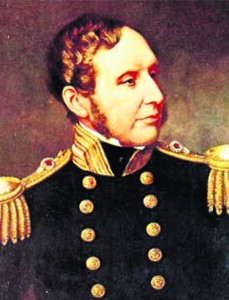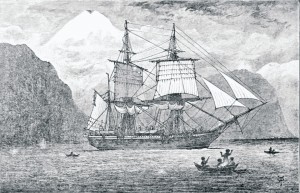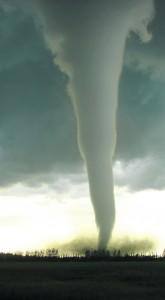MONDAY, 3 OCTOBER 2011
In 1854 a vote was taken in the House of Commons on funding for the new Meteorological Office. Laughter filled the chamber at the suggestion that it might one day be possible to predict the weather 24 hours in advance. The very idea of forecasting the weather seemed ridiculous to the Victorians, but today the Met Office is a leading source of information on weather and climate. In that time, we have come to rely on the daily forecasts and adverse weather warnings they provide. The man whose vision we have to thank for this invaluable service was the first director of the office, Robert Fitzroy.Fitzroy is better remembered as Captain of the HMS Beagle, the ship Charles Darwin sailed on, but his appointment to the Meteorological Office was the culmination of a long and varied career in service. First to the Navy, then to Parliament and even as Governor of New Zealand, he repeatedly showed a dedication to duty that shaped his life.
Born on 5th July 1805, Robert Fitzroy’s naval career was settled by the time he was twelve years old, when he enrolled at the Royal Naval College at Portsmouth in February 1818. He excelled there, completing the three year course in half the time and passing his examination for Lieutenant in 1824 with full marks, the first recruit ever to do so.
Fitzroy was an officer of exceptional ability and together with the influence of his aristocratic family he progressed quickly. When Pringle Stokes, Captain of the HMS Beagle, shot himself in a fit of depression, the Admiral in command promoted the twenty-three year old Fitzroy to the rank of Commander and made him Stokes’ successor.
The mission was to survey the Straits of Magellan and Tierra del Fuego, a task Fitzroy conducted with such attention to detail that his charts were still used over a hundred years later. He quickly grew into his role as Captain, demonstrating the conviction of command and independent thinking required when communications from home were limited to sporadic seaborne dispatches.
During this first command, Fitzroy learned firsthand the importance of acting on changing weather patterns. Caught in a severe storm, the Beagle was close to being overturned, causing two sailors to fall overboard and drown. By dropping both anchors Fitzroy saved the ship, but he felt he had failed by not acting as soon as he noticed a drop in pressure that preceded the storm.
On returning to England in 1832, the Beagle carried five Feugian natives who would ultimately lead to Fitzroy’s second command. After educating them with Christian teachings he hoped to return them to Tierra del Feugo to start a Mission, but was unable to find a posting for the return trip. On hearing this, Fitzroy’s uncle and his friend Captain Francis Beaufort, then Hydrographer to the Admirality, persuaded their Lordships to again appoint Fitzroy to the Beagle for a second survey in South America.
No expense was spared in preparing the Beagle for voyage, much of it from Fitzroy’s own pocket, and they set sail in December 1831. In addition to the usual crew compliment were the returning Feugians, a missionary, a ship’s artist, and the naturalist Charles Darwin. Darwin was there not only to examine the land they would survey, but also to be a companion to the Captain. Fitzroy had a depressive nature, was prone to mood swings, and was well acquainted with the loneliness and strain of command with both an uncle and his predecessor having committed suicide. He hoped that by carrying a scientifically minded gentleman with whom he could converse, it would prevent him from sinking into depression.
The strategy was not wholly successful. Finding it difficult to conduct the survey in the time available and unwilling to sacrifice detail to cover more ground, Fitzroy bought or hired extra boats and crews to man them. In July 1834 he received news that the Admiralty would not cover the costs he had incurred, plunging him into debt. Together with the stress of long working hours this provoked a personal crisis. He wrote a letter of resignation but withdrew it after his officers convinced him to reconsider.
Fitzroy’s spirits returned over the remainder of the voyage, and the Beagle finished her epic journey in November 1836. Just a month later Fitzroy was married and enjoying a settled period in his life. He completed charts from the survey and wrote an account of both Beagle voyages that was published in May 1839. The following years saw a departure from naval life as he was elected to Parliament in 1841, where he worked to improve conditions in the merchant fleet. Then in 1843, he was appointed Governor of New Zealand, a post in which he quickly became unpopular for openly disagreeing with how the settlers dealt with the natives and he was recalled in 1845.
Returning to the Navy, Fitzroy was made Captain of HMS Arrogant, a new hybrid ship equipped with both sail and a screw propeller turned by steam engine, the first of its kind. However, overwork and financial problems once more threw Fitzroy into depression and without loyal officers to talk him round, this time he resigned to settle his affairs. An excess of captains in 1850 left no hope of another command, paving the way for Fitzroy to take his place in meteorological history.
Interest in the weather sciences was growing and after an international conference on the subject in Brussels, the new Meteorological Department in Britain was established. Though not a scientist in the traditional sense, the many weather observations Fitzroy had made during his years at sea made him uniquely qualified to run the new office. He took up his position as Meteorological Statist to the Board of Trade on 1st August 1854.
The initial remit of the Meteorological Office was simply to collect observations of weather at sea. To achieve this, willing captains were found and provided with equipment. Fitzroy realised he could use the data to create a ‘synoptic chart’, coining the term, showing weather from a given time over a large area. With the telegraph becoming more widely used these observations could be charted quickly. Fitzroy theorized that studying synoptic charts could pinpoint recurrent patterns, enabling him to predict hazardous conditions at sea and warn mariners. When a major storm hit the British Isles destroying many vessels, Fitzroy was given the go ahead to provide such warnings. He extended his observation network to include land weather stations and with the data pouring in, the first official storm warning was issued on 6th February 1861.
Fitzroy felt more could be achieved and began to print a general daily weather ‘forecast’, a term he is also credited with, in The Times newspaper. With his forecasts sparking public interest in his new publication The Weather Book in 1862, and notification of his promotion to Vice Admiral the following year, Fitzroy had reached the pinnacle of his career.
Unfortunately, it was not to last. Criticism of the science in The Weather Book, the accuracy of his daily forecasts, and even the money ship-owners were losing from ships staying in port during storm warnings, had Fitzroy feeling attacked on all sides. The growing popularity of Charles Darwin’s Theory of Evolution by Natural Selection did little to ease his mind. Fitzroy, whose devout Christian beliefs had become more fundamental, felt responsible for what he saw as his friend’s blasphemous ideas being unleashed on the world, leading to a rift between them. Under increasing stress Fitzroy took his own life in 1865.
Robert Fitzroy was a man to whom duty meant everything. He spent his life serving the public, his friends and family, and the sailors whose safety he championed. Sadly, his achievements faded into the shadow cast by Charles Darwin, leaving him known simply as the Beagle’s Captain, but his reputation in Meteorological circles has been somewhat revived in recent years. In 2002, when a large area of sea to the west of the Bay of Biscay had to be renamed, it became the sea area Fitzroy, the only area in the British system to be named after a person. He is now daily remembered as part of the shipping forecast, reminding all those listening out for the storm warnings they rely on, just who they have to thank for the service.
Lindsey Nield is a PhD student in the Department of Physics



